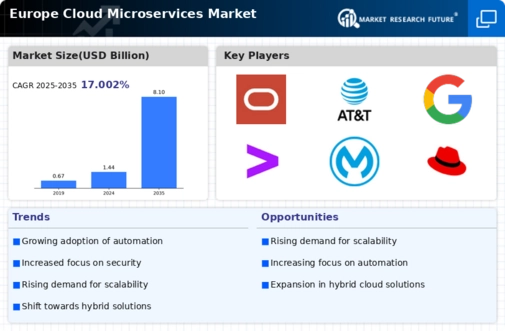Germany : Strong Growth and Innovation Landscape
Germany holds a dominant position in the European cloud microservices market, with a market value of $150.0 million, representing a significant share. Key growth drivers include robust industrial infrastructure, a strong emphasis on digital transformation, and supportive government initiatives promoting cloud adoption. Demand trends indicate a shift towards hybrid cloud solutions, driven by enterprises seeking flexibility and scalability. Regulatory policies, such as the EU's GDPR, further enhance data security and compliance, fostering a conducive environment for cloud services.
UK : Innovation and Investment at Forefront
The UK cloud microservices market is valued at $120.0 million, showcasing a robust growth trajectory. Key drivers include a vibrant tech ecosystem, high investment in digital infrastructure, and a strong focus on innovation. Demand for cloud solutions is rising, particularly in sectors like finance and healthcare, where agility and data management are crucial. Government initiatives, such as the Digital Strategy, aim to enhance the UK's digital capabilities, further propelling market growth.
France : Strong Demand in Diverse Sectors
France's cloud microservices market is valued at $80.0 million, reflecting a growing appetite for cloud solutions. Key growth drivers include the increasing adoption of digital technologies across various sectors, particularly in retail and manufacturing. The French government supports cloud initiatives through policies aimed at fostering innovation and digital transformation. Demand trends indicate a shift towards multi-cloud strategies, enhancing flexibility and resilience for businesses.
Russia : Government Support Fuels Growth
Russia's cloud microservices market is valued at $40.0 million, with significant growth potential. Key drivers include government support for digital transformation and increasing investments in IT infrastructure. Demand for cloud services is rising, particularly in sectors like telecommunications and e-commerce. Regulatory policies are evolving to support cloud adoption, while local initiatives aim to enhance cybersecurity and data protection, creating a favorable environment for cloud services.
Italy : Focus on Digital Transformation
Italy's cloud microservices market is valued at $30.0 million, with a growing trend towards cloud adoption. Key growth drivers include increasing digitalization across industries and government initiatives promoting innovation. Demand for cloud solutions is particularly strong in sectors like manufacturing and retail, where efficiency and scalability are essential. Local policies are being developed to support cloud infrastructure, enhancing the overall business environment.
Spain : Investment in Digital Infrastructure
Spain's cloud microservices market is valued at $25.0 million, reflecting a growing interest in cloud technologies. Key drivers include increased investment in digital infrastructure and a focus on innovation across various sectors. Demand trends indicate a rise in cloud adoption, particularly in tourism and finance, where agility is crucial. Government initiatives are aimed at enhancing digital capabilities, fostering a supportive environment for cloud services.
Rest of Europe : Varied Growth Across Regions
The Rest of Europe cloud microservices market is valued at $24.75 million, showcasing diverse growth opportunities. Key drivers include varying levels of digital transformation across countries and increasing investments in IT infrastructure. Demand trends indicate a rising interest in cloud solutions, particularly in Eastern European nations. Local market dynamics vary, with some regions focusing on specific industries like agriculture and logistics, creating unique opportunities for cloud service providers.

















Leave a Comment